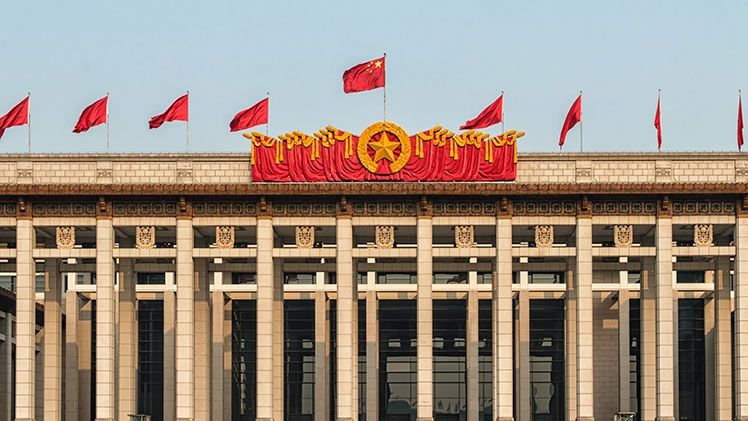China: Two Sessions, one growth target and a whole lot of questions
- 2024.14.03
- 0
- Download the publication (PDF - 314,63 KB)

In summary
In a more or less unchanging sequence of events, the Chinese New Year has given way to the “Two Sessions” (known in Chinese as lianghui), which brings together over 3,000 representatives of the Communist Party of China and the National People’s Congress. This year, though, the sequence of events was not quite unchanging: it was announced that the premier’s traditional press conference, a rare opportunity for exchange – controlled but freer than usual – with the foreign press that had been held every year since 1993, would no longer happen. There had already been one break with tradition: Xi Jinping has still not convened the plenary session of the Party’s Central Committee, tasked with approving and ratifying economic reforms.
Li Qiang, appointed to the premiership in 2023, thus had the daunting task of delivering the general policy speech and presenting the government’s most recent priorities as well as announcing key economic objectives for 2024.
Unsurprisingly, an ambitious growth target of 5% was set
The first announcement was no small thing: just like in 2023, the official growth target has been set as “around 5%”. This time, though, China can no longer rely on a favourable base effect to help it hit this target. With doubts already swirling over the veracity of the official 2023 growth figure (5.2%), the decision to keep the target at 5% is a double-edged sword.
On the one hand, it sends a clear message to economic agents: the authorities believe the economy is back in gear after four challenging years, marked by Covid and then the real estate crisis and, more generally, a lack of confidence among consumers and investors, reflected in low inflation. On the other hand, in the absence of any more stimulus measures to help achieve it, the credibility of this target has been called into question, especially with the consensus (among international organisations and private financial institutions alike) seeing growth at around 4.5% rather than 5%.
The same goes for the inflation target, which is still set at 3% even though the only time inflation has exceeded this level in the last ten years was in 2019, when it was driven up by the pork crisis. While this indicator provoked less debate in previous years, the fact that China has entered into deflation – year-on-year inflation has been zero or negative since September 2023 – highlights the disconnect and raises more questions over the benefit of keeping the target so high when it’s perfectly obvious it won’t be achieved.
Alignment over the diagnosis but uncertainty over solutions
When it comes to diagnosing the economy, the message is clear and the risks recognised: declining external demand, insufficient domestic demand, overcapacity in industry, the real estate crisis and persistent over-indebtedness in local government. These deep fractures “built up over a long period”, the so-called Grey Rhinos – risks that are identified but inadequately prepared for – have ended up materialising.
When it comes to diagnosing solutions, however, the picture is less clear. Li Qiang promised that the focus in 2024 would be on consumption… an approach already used in 2023, without much success. In reality, the authorities believe neither in the power of a consumption-led recovery nor in its multiplier effect so dear to Keynesian economists. On the contrary, they fear that consumption might create generations of entitled layabouts at a time when young people, encouraged to “eat bitterness”, are often accused of not wanting to work as hard as previous generations. In reality, the problem in China goes much deeper and highlights the paradox inherent in the country’s economy: a communist regime with no social safety net. This is especially true for migrant workers, of whom there are an estimated 250 million, who work in cities but have no access to some social services (such as unemployment and health insurance).
This paradox is the driving force behind Chinese people’s preference for saving money rather than spending it – a preference further entrenched by three years of Covid and a downturn in the labour market, particularly for young people. The authorities thus fear that these fiscal measures, even if targeted at the lowest-income households, will be useless, merely serving to increase household savings or reduce household debt.
Also, while Li Qiang said fiscal policy would remain “proactive”, the deficit is set to remain at its usual level of 3% of GDP. On the other hand, the government still has some room for manoeuvre left over from last year: not all the support measures announced at the end of last year (notably to finance infrastructure able to withstand natural catastrophes) have yet translated into actual payments. On the monetary front, caution is the watchword after sharp cuts in various rates (base rates and the mandatory reserve requirement ratio for banks) over the past few months. With the US and the rest of the world yet to embark on monetary easing, China fears further capital outflows and a weaker yuan if the interest rate differential widens.
Li Qiang also highlighted growth in the private sector fuelled by both domestic and international private investment. With foreign direct investment flows at their lowest in over 20 years ($33 billion net, compared with $185 billion in 2023), China’s message that it is open for business is still struggling to feed through into tangible investor behaviour. Nor will the passage of the premier’s speech where he talked about “complete control over law and order”, indicating that national security will continue to take precedence over economic considerations, help matters.
Having in recent years marshalled the concept of “high-quality growth”, this time Li Qiang talked instead about “high-quality development”. He was referring here to the “Big Three” (electric vehicles, solar panels and batteries), which have replaced textiles, household appliances and furniture as China’s top exports and mean higher added value in Chinese supply chains. But these are also the sectors in which there is excess manufacturing capacity, which means external demand will be key.
Slamming “protectionism and unilateralism”, which have “gained ground”, China takes a very dim view of emerging discussions within the European Union over the introduction of barriers to entry for Chinese electric vehicles, and of the decision to investigate Chinese government subsidies in the industry. Chinese manufacturers are primarily counting on the European market to rebuild their margins.
On the geopolitical front: higher military spending
As it did last year, China has announced a 7.2% increase in its military budget, which therefore once again exceeds its growth target. Yet China’s military budget – the world’s second highest after the US, at over $230 billion – continues to be underestimated: a big chunk of research and development expenditure, seen by China as civilian even though its results are mainly used in the military (especially in the field of cybersecurity), is not included.
Confrontations in the South China Sea have been more frequent over the last few months, particularly with the Philippines, locked in a dispute with China over control of the Spratly Islands. The ASEAN nations, which last week attended (apart from Myanmar, which was not invited) a joint summit with Australia, have condemned “unsafe conduct at sea and in the air” and “destabilising, provocative and coercive actions”. Another incident that same week left four Filipinos injured. It seems unlikely that peace is in the offing.
Our opinion
The Two Sessions concluded after a week of meetings that left few certainties and a whole lot of questions. One thing above all is certain: the Party and its leader Xi Jinping continue to tighten their grip, as foreshadowed by the decision to scrap the premier’s traditional press conference and confirmed by the passing of a law that says the government’s role is to “resolutely implement the Party Central Committee’s decisions”. This also means we should not expect to see any lessening of the emphasis on national security – something that might have brought some relief to the private sector, particularly in the field of new technologies. Meanwhile, most of the questions have to do with the management of economic policy. In choosing an ambitious target that exceeds consensus forecasts, the authorities could, in an effort to reassure markets disorientated by the last few months’ disappointing statistics, have been less tight-lipped about how that target is to be achieved. Instead, there have been few specifics about what kind of fiscal stimulus might be put in place, particularly in the real estate sector, still in the grip of a crisis. Far from being an exercise in transparency, the Two Sessions have only heightened the perception of an increasingly opaque China.

When it comes to diagnosing the economy, the message is clear and the risks recognised: declining external demand, insufficient domestic demand, overcapacity in industry, the real estate crisis and persistent over-indebtedness in local government. These deep fractures “built up over a long period”, the so-called Grey Rhinos – risks that are identified but inadequately prepared for – have ended up materialising. When it comes to diagnosing solutions, however, the picture is less clear. Li Qiang promised that the focus in 2024 would be on consumption… an approach already used in 2023, without much success. In reality, the authorities believe neither in the power of a consumption-led recovery nor in its multiplier effect so dear to Keynesian economists.
Sophie WIEVIORKA, Economiste - Asia (Excluding Japan)
